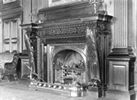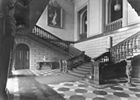 |
||||||||
| Hamilton Palace (site), Hamilton, South Lanarkshire | ||||||||
 © Lennoxlove House Ltd |
Long Gallery, chimney flues, 1843 |
|||||||
|
This 1:60 scale drawing is one of 20 similar drawings grouped in a bound leather royal folio volume, the spine of which bears the title 'Hamilton Palace Chimney Vents 1843'. The title page sets out more fully that these drawings are 'sections of all the different chimney vents of the new and old Palace of Hamilton commencing at the west-end of the new palace, taken by Mr Thomas Harvie, superintendent of masons, and drawn etc by Thomas Boyd, Engineer and Surveyor, Hamilton 1843’. This longitudinal section through the gallery shows the pair of old flues which served those fireplace openings in the north side wall of the gallery that had been re-fitted with new black marble chimneypieces in the 1820s. Of the 12 flues shown in this drawing, one serves one of the pair of free-standing radiators in the ground-floor hall, and the two shaded in pink are redundant flues on the 'opposite side of gable'. Altogether, some 102 flues are shown on the 20 drawings. Whilst some vents may have been depicted more than once and some 13 flues are described as 'not in use', it is a very impressive measure of the heating provision in the new palace and the likely requirements in terms of fuel (coal) consumption and attendant maintenance. In 1843, the date of this publication, the coal industry in this area was still in its infancy, with only one operational coal mine in Hamilton district. Three decades later there were no fewer than 40 in Hamilton burgh and parish alone. By the 1870s, however, the accumulated debts on the estate and the costs of upkeep were already beginning to make themselves felt, resulting in the first major sale of the contents of the palace in 1882. |
||||||||
|
|
|
|
|
|
|
|
|
|
 David
Hamilton's letter David
Hamilton's letter |
 Lord
Basil Hamilton's letter Lord
Basil Hamilton's letter |
|||||||
|
|
|
|
|
|
|
|
|
|

